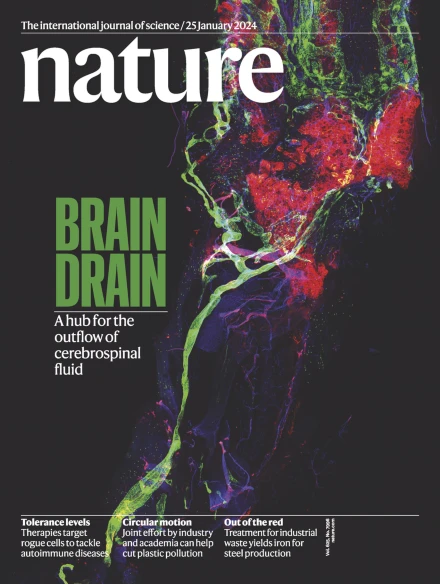A gut sense for a microbial pattern regulates feeding.
IF 50.5
1区 综合性期刊
Q1 MULTIDISCIPLINARY SCIENCES
引用次数: 0
Abstract
To coexist with its resident microorganisms, the host must have a sense to adjust its behaviour in response to them. In the intestine, a sense for nutrients transduced to the brain through neuroepithelial circuits guides appetitive choices1-5. However, a sense that allows the host to respond in real time to stimuli arising from resident gut microorganisms remains to be uncovered. Here we show that in the mouse colon, the ubiquitous microbial pattern flagellin-a unifying feature across phyla6-stimulates Toll-like receptor 5 (TLR5) in peptide YY (PYY)-labelled colonic neuropod cells. This stimulation leads to PYY release onto NPY2R vagal nodose neurons to regulate feeding. Mice lacking TLR5 in these cells eat more and gain more weight than controls. We found that flagellin does not act on the nerve directly. Instead, flagellin stimulates neuropod cells from the colonic lumen to reduce feeding through a gut-brain sensory neural circuit. Moreover, flagellin reduces feeding independent of immune responses, metabolic changes or the presence of gut microbiota. This sense enables the host to adjust its behaviour in response to a molecular pattern from its resident microorganisms. We call this sense at the interface of the biota and the brain the neurobiotic sense7.肠道对微生物模式的感知调节着摄食。
为了与寄生微生物共存,寄主必须有一种感觉来调整自己的行为以应对它们。在肠道中,对营养物质的感知通过神经上皮回路传导到大脑,引导食欲选择1-5。然而,一种允许宿主实时响应来自常驻肠道微生物的刺激的感觉仍有待发现。在小鼠结肠中,无所不在的微生物模式鞭毛-跨门的统一特征-刺激肽YY (PYY)标记的结肠神经足细胞中的toll样受体5 (TLR5)。这种刺激导致PYY释放到NPY2R迷走神经结节神经元以调节摄食。这些细胞中缺乏TLR5的小鼠比对照组吃得更多,体重增加更多。我们发现鞭毛蛋白并不直接作用于神经。相反,鞭毛蛋白刺激来自结肠腔的神经足细胞,通过肠-脑感觉神经回路减少进食。此外,鞭毛蛋白减少摄食独立于免疫反应,代谢变化或肠道菌群的存在。这种感觉使寄主能够根据其常驻微生物的分子模式调整其行为。我们把生物群和大脑交界处的这种感觉称为神经生物感觉。
本文章由计算机程序翻译,如有差异,请以英文原文为准。
求助全文
约1分钟内获得全文
求助全文
来源期刊

Nature
综合性期刊-综合性期刊
CiteScore
90.00
自引率
1.20%
发文量
3652
审稿时长
3 months
期刊介绍:
Nature is a prestigious international journal that publishes peer-reviewed research in various scientific and technological fields. The selection of articles is based on criteria such as originality, importance, interdisciplinary relevance, timeliness, accessibility, elegance, and surprising conclusions. In addition to showcasing significant scientific advances, Nature delivers rapid, authoritative, insightful news, and interpretation of current and upcoming trends impacting science, scientists, and the broader public. The journal serves a dual purpose: firstly, to promptly share noteworthy scientific advances and foster discussions among scientists, and secondly, to ensure the swift dissemination of scientific results globally, emphasizing their significance for knowledge, culture, and daily life.
 求助内容:
求助内容: 应助结果提醒方式:
应助结果提醒方式:


